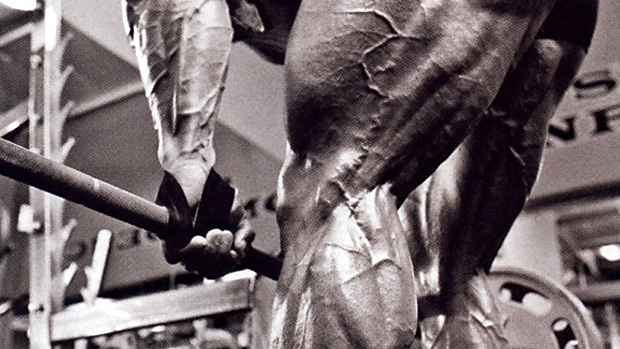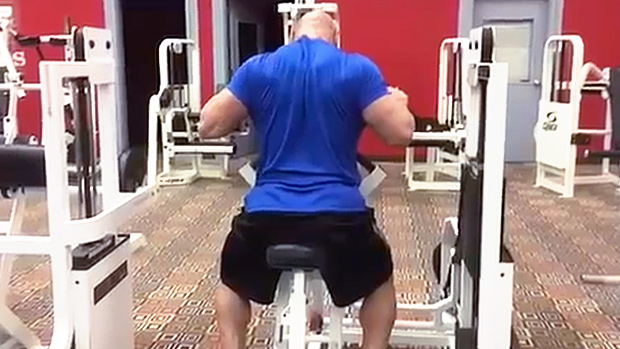Sure, it's a dull subject, but ignore this point at your own peril, you risk-taker, you:
Tight hamstrings can be a minor nuisance or a major impediment to your ability to lift or sprint. If tight hamstrings become dominant in posterior-chain movements, you can end up vulnerable to muscle pulls that force you to spend valuable training time on the sidelines.
Worst-case scenario, when the hamstrings become too short or stiff — these aren't the same thing, as I'll explain in a moment — they can pull your pelvis into a backward tilt. Your natural lumbar curve disappears, and you end up with a flat-back posture. Buttless, in other words.
And then how will you hold your pants up, smart guy?
Besides that, buttless is where the potential for relatively minor injuries, like muscle pulls, morphs into the risk for a truly serious back injury.
When everything's going right, and your hamstrings are at their normal length, a deadlift works like this: Your hips displace backwards, allowing your spine to stay in the neutral position — that is, maintaining its natural arch. From this position, the glutes, hamstrings, and spinal erectors all contract together to bring your body safely into the upright position. If the gym gods are smiling on you that day, you might even hit a PR.
But if you have short hamstrings and a flat-back posture, the tightness limits the backward motion of your hips. That means your lower back goes into flexion, which is when the risk for injuries increases dramatically.
So let's look at some ways to avoid all that.
Are Your Hamstrings Too Tight?
Here's a quick test to help you determine if your hamstrings are tight:
While standing, slowly shift your weight back to your heels, and push your hips back as far as possible. Stop immediately when your lower back starts to round. This is the full length of your hamstrings. You want the angle between your thighs and torso to be about 90 degrees. If you're not able to bend at least this far, your hamstrings probably need some work.
But if you don't reach that magic number, it doesn't necessarily mean your hamstrings are too short. They might be the right length, but pulled tight because of a pelvis that tilts forward. In this case, the hamstrings are actually trying to restrain the pelvis from tilting farther forward; the result is the tightness you feel in the back of your legs.
You need to know which best describes your situation before you go nuts and start stretching your hamstrings like Gumby on speed. If the problem is anterior pelvic tilt, you could make the problem worse by lengthening your hamstrings. That would allow your pelvis to tilt farther forward.
To rectify this problem, you need to first address the position of your pelvis, which probably has more to do with tightness in your hip flexors than your hamstrings. That means stretching your hip flexors. Once that's accomplished, your hamstring tightness should improve without you having to lengthen the hamstrings themselves.
Stiffness vs. Shortness
You've probably heard this before, but it's worth repeating:
If a muscle lacks length, it's because of adaptive shortening. That is, your posture, or an injury, or the way you use (or don't use) the muscle has caused it to become shorter. That changes the range of motion for the joint the muscle acts upon, which can create systemic problems. Other muscles adjust by lengthening or shortening, and other joints might develop compromised mobility or stability to accommodate the inadequate range of motion created by the short muscle.
By contrast, a stiff muscle is as long as it needs to be, and shouldn't keep a joint from going through its full range of motion. It just has greater resistance to stretch.
I like the way Bill Hartman explains it:
"Think of two rubber bands made of the same material, but one rubber band is wider than the other. The materials would have equal extensibility. But because one has greater width, it takes more force to stretch it the same length as a thinner band."
So what can you do about it?
If the problem is length, it might be clear from your posture. If you've been told more than a few times that you have a great butt, there's a possibility that you have short, tight hip flexors pulling your pelvis forward, which makes your butt appear more prominent (and also makes your belly stick out a bit, even if you're relatively lean). If you have no butt at all, chances are you have a flat back, the result of adaptively shortened hamstrings and weak, lengthened hip flexors.
Short muscles tend to respond best to prolonged periods of stretching to encourage lengthening. It often takes a while to see improvements.
But if the problem is stiffness, a common problem among serious lifters, the techniques I describe below often alleviates the problem within minutes. You can do the first three before your workouts, as part of your warm-up.
Tip #1: Roll It Out

In Thomas Myers' book Anatomy Trains, he talks about something called the superficial back line, a system of connected muscle and fascia that runs from the underside of each foot, up the back of the body, and over the scalp to just above the eyes. It includes your calves, hamstrings, and spinal erectors.
Based on this concept, a restriction anywhere along that line can affect other elements of the musculoskeletal system along the same line. Think of a loose thread in a sweater: Pull on one end, and you'll get bunched-up material somewhere else. With the superficial back line, tightness in the plantar fascia on the bottom of your foot can impair your hamstring flexibility.
To see if your hamstring problem originates in your feet, you first need to test your hamstring flexibility, using the test I described earlier.
Now grab a tennis ball, place it on the ground and begin rolling the underside of your foot. Make sure to use a reasonable amount of pressure, and go along the length of the foot on the inside, middle, and outside edge. Personally, I've found that most people have a tender spot just in front of the heel that needs the most work. I suggest spending one or two minutes on each foot.
Now retest your flexibility. Again, make sure not to round the back to convince yourself that you have more range. If indeed your range of motion has increased, you know that fascial restrictions could be causing your hamstring stiffness, and you should include the tennis-ball roll as part of your warm-up routine. As it gets easier, you can progress to a baseball or golf ball. Just be sure to take it easy at first; if you don't, you'll bruise your foot and end up hobbling around like a senior citizen.
I've also found that foam rolling on your calves magnifies the effectiveness of this technique. It frees up the superficial back line even more.
If you find that one foot or leg responds better than the other, especially if the nonresponsive tissue is at the site of a previous injury, you might want to invest a few bucks in some soft-tissue therapy. Active Release Techniques or Graston could be well worth the expense. These therapies can be painful, but if you're tough enough to make it through a Tabata workout, I think you'll survive.
Tip #2: Beat It Out

A few months ago, at a seminar with chiropractor and former T NATION contributor Ken Kinakin, one of his colleagues presented a crazy-looking vibrating machine. (It's not what you're thinking, and it wasn't that kind of seminar.)
First, a little background: The matrix that surrounds our muscle cells contains water, fibers (like collagen and elastin), and something called "ground substance" (glycoproteins and glycoaminoglycans, if you really want to know). In healthy muscle tissue, you'll have enough water to keep the matrix soft and fluid. But in unhealthy muscle, there's less water and the matrix becomes increasingly gelatinous, a condition called myogelosis. It interferes with movement and creates fascial restrictions.
That's where the vibrating machine, called a percussor, comes in handy. It can make the ground substance more fluid like and restore the muscle to optimal function. It also doesn't take as long as other forms of myofascial release, and isn't nearly as painful.
I soon discovered that you can get the same benefits without the machine. Like so many of the best things in life, you can do it with your hand. You might get a few stares if you start hitting your hamstrings in public, but it's worth it.
Sit on the edge of a chair, and make a fist with your hand. Percuss your hamstrings by hitting them repeatedly, as fast as you can. You have to use some force, but the object isn't to leave bruises. Be sure to move around the hamstrings, hitting various areas.
If it works for you and you decide to share the benefits with your significant other, I suggest warning her before you start pounding on her hamstrings. Apparently, this isn't considered sexy.
Tip #3: March It Out
Static flexibility is important, but it doesn't always transfer to active mobility. That's why the bicycle hamstring stretch, which I picked up from Charles Staley, is a great addition to a warm-up protocol.
The easiest way to do it is with a training partner:
Lie on your back, and have your training partner bring your knee up toward your chest. When the knee reaches your chest, your partner should straighten your leg as far as it'll go, at which point you should feel a stretch in your hamstrings. Your partner then brings it down to the starting position.
Repeat this bicycle motion about eight to 10 times per leg. You should feel the hamstring letting go and the range of motion increasing with each repetition.
If you don't have a training partner, or you just don't particularly enjoy a fellow gym rat being all up near your man parts, you can try a warm-up drill called toy soldiers, which I borrowed from Mike Robertson and Eric Cressey's Magnificent Mobility DVD. While standing tall, place one hand in front of you at shoulder height, and swing the opposite leg toward that hand until you feel a stretch in the hamstring. Repeat with the opposite leg, and continue until you've done eight to 10 reps with each leg. Try to make the movements rhythmic, rather than ballistic.
Tip #4: Stretch It Out
While the first three drills fit easily into a pre-workout warm-up routine, I think this PNF stretch works best after training.
The goal of PNF — short for proprioceptive neuromuscular facilitation (but you knew that) — is to trick your Golgi tendon organ into allowing the muscle to relax. The GTO is a protective mechanism that sits in the spot where your muscle fibers end and your tendon begins. It monitors tension in your muscle, and sends that data to your central nervous system. If your brain and/or spinal column sense the potential for damage due to a sudden change in the demand placed on the muscle, your nerves will send the "fail" signal back to the muscle.
In those cases, the muscle will lengthen to prevent the injury. Thus, PNF stretching works with your GTO to convince the muscle to lengthen more than it ordinarily would, and thus allow a deeper stretch.
The PNF stretch I'm about to show you can be done with or without a partner, and I'll provide an example of both.
If you have a training partner, lie on your back and have your partner raise one of your legs straight up into the air. While you're in this position, your partner kneels with one knee on your other leg to pin it down. If you plan to have children, you need to pay special attention to where the partner puts that knee. And, as an added precaution, I'd advise against using a partner to whom you owe money, or who might be holding a grudge against you for any other reason. Yes, you're that vulnerable during this stretch.
Now your partner puts your working leg against his shoulder and leans in until you feel a gentle stretch in your hamstring while keeping your knee straight. Hold this position for 10 seconds. Then, as your partner braces himself, push down into his shoulder for six seconds, using all the force your hamstring can generate.
The partner has to be pretty strong and solid for this to work, because he has to take the force of your hamstring contraction without letting your leg change position. If you're too strong or your partner is too weak, you could end up knocking him across the room. If he didn't hold a grudge before, he will after that. Remember where he's going to put his knee on your next stretch.
After six seconds, release the contraction and allow your leg to relax for a second or two. That's when your partner should be able to lean in farther and take your leg into a deeper stretch. It should feel relatively easy, as if someone took the brakes off and your muscle instantly relaxed. Stay in this stretched position for about 10 seconds, then repeat the process with the other leg.
If you do this on your own, stand tall with one heel up on a bench and your leg straight. Bend forward at your hips until you feel a stretch in the hamstring. From here, the process is the same. Hold the position for 10 seconds, then forcefully drive your heel down into the bench using your hamstrings. After six seconds, release the contraction. Your body should be able to move into a slightly deeper stretch. Hold for 10 seconds, and repeat with the other leg.
With or without a partner, you can repeat this PNF stretch up to four times on each side, if needed.
Bonus Tip: Instant Cramp Relief
Let's say you've just worked your hamstrings to exhaustion, and now one of them is cramping up. You might get the same feeling when you make a pit stop after a long drive; you can't put weight on that leg, or even straighten your knee on that side. This would be the perfect time to use a technique called strain-counterstrain, otherwise known as positional release.
It was first developed by Lawrence Jones, and isn't really used for lengthening muscles. But it's the single most effective tool I've found to alleviate hamstring cramps.
Lie on your stomach and have a partner bend your knee, bringing your heel to your butt. Then, while still holding your foot firmly in this position, the partner lifts your knee off the ground to fully extend your hip.
The key here is that your hamstring is maximally shortened, which is why you flex the knee and extend the hip simultaneously. It's also important that the partner actually holds your leg in this position so you don't contract your hamstrings. They should be totally relaxed.
Have the partner hold you in that position for 90 to 120 seconds. Anything less than 90 seconds won't help. Then, when your partner lowers your leg, it's absolutely essential to do it very slowly. Go too fast, and the muscle will grab again, and you're right back where you started. Do it right and you should experience almost immediate relief.
Stringing It Out
The consequences of tight hamstrings are annoying in the short run, and potentially disastrous over time. Whether the problem is caused by muscles that are too short or too stiff, the result is the same: You'll have a substandard range of motion, which affects your performance in the gym and in most sports. You'll also be at greater risk for acute or chronic injuries, ranging from hamstring pulls to potentially debilitating back injuries.
The exercises and techniques I described here can provide instant or near-instant relief. But they don't improve your long-term outlook unless you do them regularly.
I recommend soft-tissue work, usually with a foam roller but also with a tennis ball on the bottom of your foot if it seems to help, before every workout. It doesn't hurt to repeat the exercises on the days you don't train as well.
The mobility drills I described, with or without a partner, should also be a part of your pre-workout routine. And if your hamstrings are chronically stiff, try percussing them before workouts as well.
The PNF stretch is a great exercise to do after a workout. Over time, you should see real improvement in your hamstring flexibility.
Separately or together, they should help you relieve chronic hamstring tightness. And even if you don't have particularly problematic hamstrings, these drills can help ensure you never do.





